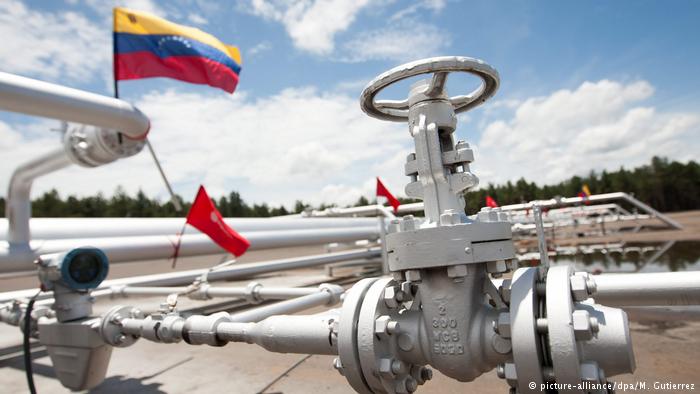
(Barron’s, 23.Oct.2023) — The U.S. administration’s new oil sanctions relief toward Venezuela is broad-ranging and impactful. It’s unlikely to have any immediate effect on international oil prices, but it will likely realign the regional oil trade, which will benefit the U.S. refining system. It will also test whether a different foreign policy—and sanctions—strategy toward Venezuela can have any impact on the country’s democratic prospects, especially after Sunday’s opposition primaries. Presidential hopeful Maria Corina Machado, barred from running from office, appears to have won by a landslide.
The sanctions relief was announced on Oct. 18 as a general license, following negotiations between Washington and Caracas. The Nicolás Maduro regime is on paper committing with the Venezuelan democratic opposition to freer and fairer presidential elections in the second half of 2024. Press reports of behind-the-scenes negotiations had already set expectations for some easing of sanctions, but the official result was surprisingly expansive. U.S. and international companies will be allowed to trade Venezuelan oil and transact with Venezuela’s national oil company, PDVSA, as well as with the government, the state mining company, and the Venezuelan central bank. More than a license, it seems the equivalent of a temporary suspension of oil sanctions for six months.
Oil markets didn’t move significantly in the wake of the news. That’s a testament to international skepticism about how much new oil production from Venezuela can be expected. In fact, the most significant implication is likely to be a redirection of sanctioned Venezuelan oil, which had been flowing to black markets (largely in China), into the U.S. Gulf Coast refining system. Such a redirection of trade would lead to a ramp up of Venezuelan oil exports to the U.S. While, it could represent 300,000-400,000 barrels a day in Venezuelan oil exports to the U.S., it would likely be below pre-sanctions levels of almost 500,000 barrels a day in 2018. A license to Chevron last year has already led to about 150,000 barrels a day in Venezuelan oil exports to the U.S. in the last few months, from zero last year). While the change is unlikely to have a meaningful impact on global oil or fuel prices in the near term, this trade shift will benefit the U.S. Gulf refining system, which is eager to obtain heavy crudes.
Sanctions relief may allow for some additional production. But how much is difficult to assess with precision because sanctions were only one of many problems plaguing Venezuela’s oil industry. The country was producing about 1.5 million barrels a day before U.S. oil sanctions were imposed in 2019, but it will be difficult to return to that level in the next few years without significant institutional, political, and economic reforms. Our base case scenario is 200,000-300,000 of incremental production in the next one to two years. This would take Venezuela’s oil production from 750,000-800,000 barrels a day currently to some one million barrels a day. That increase includes some 100,000 barrels a day from Chevron’s joint ventures. That production would have happened anyway within their existing license.
Even though it would be profitable to ramp up production from existing fields, especially while oil prices remain high, our rather conservative scenario for oil production increases is informed by the many constraints that exist. Maduro needs significant amounts of cash for the electoral cycle, and is likely to use all of PDVSA’s cash flow for public spending, not for oil investments with future payoffs.
This makes more optimistic scenarios about the outlook for oil production contingent on the ability of cash-starved Venezuela to attract international capital to jump start its industry. Many obstacles stand in the way. First, is the obligation of any partner to enter into a joint venture with the national oil company, PDVSA. That poses a significant compliance risk, given PDVSA’s extremely poor environmental, social, and governance standards even among national oil companies. Second, most of the country’s infrastructure is in dire shape. Third is Venezuela’s weak macroeconomic stability, large unpaid liabilities, and lack of credible property rights and transparency, all of which imply high risk premium. Also, the fact that the sanctions relief is taking place in the context of a six-month license might make it very difficult for international investors to commit capital in a high-interest rate environment.
From the U.S. government’s point of view, the geopolitical and domestic incentives for such an agreement are multiple, including oil-market risks linked to Russia’s invasion of Ukraine, OPEC’s continuation of production cuts, the uncertainty of whether the Gaza conflict could expand into a broader regional conflict, and the significant increase in Venezuelan refugees crossing the U.S. border. The perceived need to change U.S. foreign policy to promote democratic change is a key motivation, given the Biden administration’s conviction that the previous administration’s maximum pressure policy against Maduro had failed and made the humanitarian crisis that predated the sanctions worse.
From the Maduro’s regime perspective, the expansive license is a clear win. It gets sanctions relief up front without a perceived quid pro quo of equivalent value up front. Its obligations are pledges and promises of electoral fairness, an electoral timetable, and the release of political prisoners. With sanctions relief, Venezuela gets to maximize cash revenue from oil exports that were being sold at a steep discount in the black market. Cash from exports could come close to doubling in the next few months. True, the U.S. government has an enforcement mechanism to keep the notably unreliable Venezuelan regime accountable to its pledges: It can revoke or not renew the license. However, if the license is revoked, Maduro will keep the windfall cash and any incremental production. Moreover, critics argue that once in place, licenses are difficult to reverse. The threshold for doing so could be high in the current geopolitical, electoral, and oil market environments. Still, the use of licenses to condition behavior and adapt to changing circumstances does provide flexibility.
The endgame for Maduro is to be recognized as the legitimate president of Venezuela while minimizing political costs and concessions. It is very likely that the six-month probation period in the license will be tested, as the Maduro regime appears unwilling to allow Machado to register as a presidential candidate. Early voting results indicate she won Sunday’s opposition primaries by a landslide. The U.S. has signaled allowing all political candidates to run as a condition for the license renewal and that it would be ready to walk away from the deal as soon as November if there are no concrete steps. The incentives for Maduro will be to try to pass this first test by doing the minimum necessary. Instead, Maduro may be planning to see if the election spending spree lifts his chances of winning a minimally free election, by dividing the opposition and abusing his incumbency advantage. In case that doesn’t work, he’ll likely resort to flipping over the political board, Nicaragua-style, risking that the U.S. re-enacts the oil sanctions.
____________________
About the authors: Luisa Palacios is senior research scholar at Columbia University’s Center on Global Energy Policy. Francisco Monaldi is fellow and director of the Latin American Energy program at Rice University’s Baker Institute for Public Policy.

